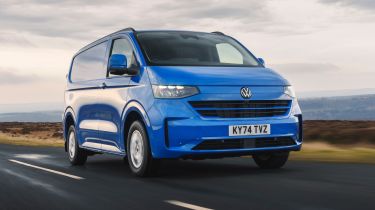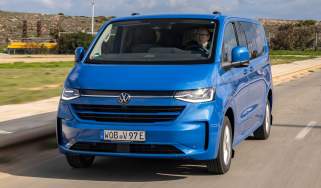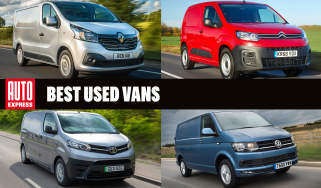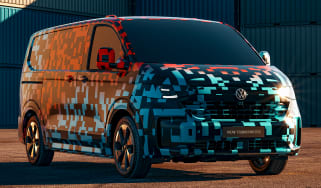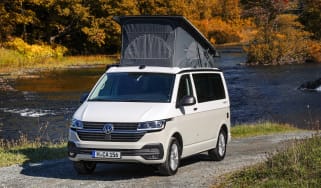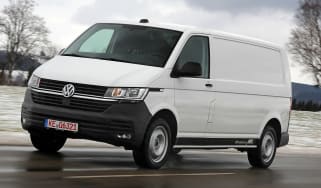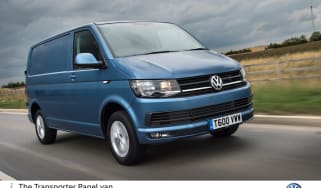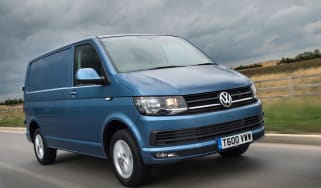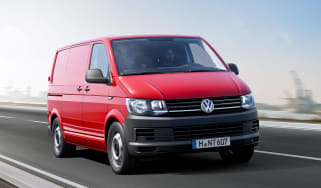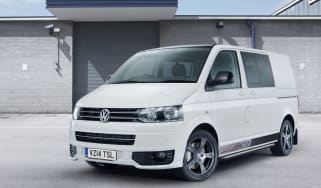Volkswagen Transporter van review
The latest Volkswagen Transporter is based on the Ford Transit Custom, both are top vans but a few things help the VW stand out
Our opinion on the Volkswagen Transporter
The latest Volkswagen Transporter now shares a great deal with the top-selling Ford Transit Custom as a further continuation of the two brands' ongoing partnership. Some may bemoan that the Transporter has lost some of its individuality as a result, but elsewhere, things are very positive.
The latest Transporter has more space, impressive payloads and once every version arrives, it’ll be offered with diesel, electric and PHEV power to best suit the needs of customers. There are even some reasons to pick the VW over the Ford - its wheel arches are lined as standard for better refinement, and most notably, it gets a five-year warranty and five years of servicing as standard.
About the Volkswagen Transporter
They say you should keep your friends close and your enemies even closer. Volkswagen clearly subscribes to this mantra, because its seventh-generation Transporter panel van and Shuttle people carrier share a good deal with the Ford Transit Custom. It’s part of a collaboration that’s already given us a Volkswagen Caddy-based Ford Transit Connect and a Volkswagen Amarok derived from the Ford Ranger, so the question is, can the Transporter beat the Transit Custom at its own game?
Spoiler alert, but which option buyers end up choosing is likely to come down to the nitty gritty of specifications, which van is offered on a better deal or which badge they prefer – and if it’s not already obvious, the Transporter and Transit Custom are very closely matched. There are some notable differences, though, and something as simple but important as the standard five-year aftercare packages and warranty VW throws in as standard could swing it.
Used - available now

2021 Hyundai
Ioniq electric
58,635 milesAutomaticElectric
Cash £8,875
2022 Nissan
Leaf
26,377 milesAutomaticElectric
Cash £9,325
2020 Mercedes
GLA
45,011 milesAutomaticPetrol1.6L
Cash £17,000
2019 Ford
S-Max
72,237 milesAutomaticDiesel2.0L
Cash £15,000Volkswagen claims that space, payload, towing ability, and features are all improved over the outgoing T6.1 Transporter, plus there’s a host of engine options to pick from. As before, there’s a 2.0-litre TDI diesel, which comes in 109bhp, 148bhp or 168bhp outputs. This engine has a six-speed manual in 109bhp form, while an eight-speed automatic is standard with the 148bhp and 168bhp versions. The brand’s 4MOTION four-wheel drive system is an option if you pick the 148bhp diesel.
Urban-based fleet operators will be most interested in the electric versions with 134bhp, 215bhp or 282bhp and rear-wheel drive, a 64kWh battery and a range of around 200 miles. Arriving in 2026, there’s also the Transporter eHybrid plug-in hybrid with a 2.5-litre petrol engine, electric motor and battery pack for customers who need to drive into city centres as well as regularly tackling longer trips.

Numerous versions of the Transporter will be available, kicking off with the short and long wheelbase panel vans that are arriving first, followed by high-roof versions with up to nine cubic metres of load space, a Kombi, dropside and even a Transporter Shuttle passenger version with up to nine seats. Measuring 5,050mm in short wheelbase guise, the Transporter is 146mm longer than the T6.1, resulting in a 61mm longer load compartment, while its wheel arches have also been pushed further apart to boost load space by around five per cent.
In the UK, the Transporter is available in Commerce, Commerce Plus, and Commerce Pro trims, with the entry model featuring black bumpers, 16-inch alloy wheels, LED headlights, rear wing doors, and a sliding side door on the passenger side. The aforementioned infotainment set-up is standard, and it includes rear parking sensors and keyless start. Upgrading to the Commerce Plus version adds items including body-coloured exterior trim, a spare wheel, front parking sensors, a reversing camera and an anti-theft alarm. Commerce Pro raises the luxury with heated seats, adaptive cruise control (for automatic gearboxes), air-conditioning, a heated windscreen, additional charging ports and extra LED load compartment lighting.
MPG and running costs
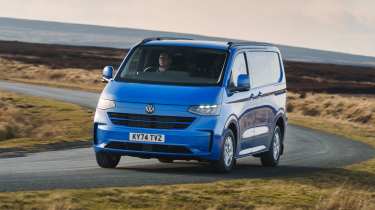
Pros |
Cons |
|
|
Volkswagen clearly wants the Transporter and its Shuttle passenger derivative to appeal to more customers than ever, because there will be no less than seven powertrains to choose from, spanning diesel, electric and plug-in hybrid (PHEV). The latter is set to arrive in 2026, and will be the first time a PHEV has ever been offered in the Transporter.
Stick with diesel, and these are engines carried over from the Transit Custom, so while there have been some minor aerodynamic tweaks, the Transporter can only hit a maximum of 40.9mpg while emitting 181g/km. That’s in its entry-level 2.0 TDI diesel, short wheelbase guise with a six-speed manual gearbox; with 148bhp and an eight-speed automatic, it posts 37.7mpg (196g/km). Add 4MOTION four-wheel drive, and this sinks slightly further to 34mpg, and it puts out at least 218g/km, so you’ll want to consider how often you tackle slippery terrain before ticking this option.
This is fractionally ahead of the 40.4mpg of the Ford Transit Custom and matches the 40.9mpg of the Renault Trafic 2.0 130 DCi manual. The Transporter comes standard with a 55-litre fuel tank, which is quite a bit smaller than the 80-litre tank of the Renault, so drivers will need to pull in a bit more often on really long trips.
Just like its Ford sister vehicle, the Transporter gets a PHEV option, badged eHybrid, but not until next year, and VW is targeting city-based operators who require a longer range for an occasional extended trip. While official specs haven’t been confirmed, it’s expected to get the same 11.8kWh battery as the Ford, for an electric-only range of around 34 miles before the petrol engine kicks in. If it does indeed match the Transit Custom, expect an official economy figure of just under 180mpg – with the usual caveat that you’ll need to regularly charge to get close to that figure in the real world.
Electric range, battery life and charge time
The e-Shuttle and e-Transporter both use a 64kWh lithium-ion battery, with a WLTP range of up to 201 miles for the 134bhp version – eight miles down on the Ford. This is a slightly smaller capacity than the electric Transit Custom, which can go 236 miles between charges. The e-Shuttle can charge at up to 11kW using an AC charger and 125kW using a DC rapid charger, for a top-up from 10-80 per cent in as little as 39 minutes – that’s the same peak charging speed as the Ford.
VW trumps Ford and Renault’s three-year/100,000-mile warranty thanks to its impressive and standard ‘5+ Promise’ that includes a five-year/124,000-mile warranty, five services, two MoTs and five years’ roadside assistance. This alone could sway buyers wondering why they’d pick the VW over the Ford or one of its other rivals.
Load space and practicality
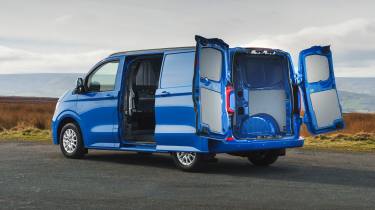
Pros |
Cons |
|
|
Versus the outgoing Transporter T6.1 there’s more space and increases in both payload and towing figures. The standard height panel van has 5.8 cubic metres of capacity, and the sliding side door measures 1,030mm by 1,301mm. Cargo volume grows to nine cubic metres for the long wheelbase high-roof version, which can accommodate three standard pallets – two loaded from the side and one from the rear.
The gap between the Transporter’s rear wheel arches has grown by a very useful 148mm to 1,392mm. The load compartment has also grown, gaining 61mm in length (2,602mm total) in standard length, while the long wheelbase version tops out at 3,002mm. Customers can also pick between a rear tailgate or wing doors. Sadly, you won’t be able to get the same L-shaped bulkhead offered in the Transit Custom that provides a full-length load area for pipes and long planks, but there is a load-through hatch into the space under the bench seats inside the cabin.
VW was keen to tell us it had targeted a payload of more than one tonne for the latest Transporter, with up to 1,088kg in the e-Transporter and 1,280kg in the diesel. It’s important to check the payload for the precise version you’re ordering, because it can drop as low as 767kg in the long wheelbase 148bhp diesel automatic. Again, depending on the spec, the Transporter can tow up to 2,800kg (300kg more than the T6.1) and carry 170kg on its roof, which is a 20kg increase.
Buyers will be able to spec the Transporter Shuttle (still called Caravelle in Europe) with eight or nine seats, and VW sees it as a more commercial offering aimed at, well, executive and airport shuttle drivers, while both the VW Multivan and VW ID. Buzz cater to recreational buyers. Pick the most basic Shuttle and there are three individual seats in the middle row, along with a removable three-seat bench for the third row. Legroom impresses, particularly in the long wheelbase version. The Transporter Shuttle gets a giant hatchback, which doesn’t take too much effort to open and close, but requires a fair bit of room to be left behind the vehicle for it to swing out into.
Reliability, safety and security
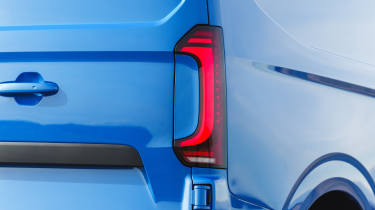
Pros |
Cons |
|
|
Safety used to be a bit of a sore subject for vans, but independent crash-test body Euro NCAP has upped its testing of late, helping to promote increased safety levels. The Transporter gained the top rating, with a 96 per cent safety score and Platinum award. Safety kit includes items such as autonomous emergency braking, lane assist, traffic sign recognition and driver, front passenger and curtain airbags.
There’s also some extra safety kit in higher trims, with the Commerce Plus adding front parking sensors, a rear-view camera and towing protection. The Commerce Pro grade adds cross traffic and lane assist, blind spot and exit warnings and adaptive cruise control.
Being an all-new model, there’s no data yet on how reliable the Transporter will prove to be. If there are any issues, the Transporter’s ‘5+ Promise’ includes five years of roadside assistance.
Driving and performance
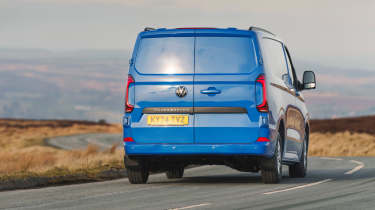
Pros |
Cons |
|
|
The Transit Custom already has a reputation for being the best van to drive, so the Transporter has a good platform to build upon. The steering of the Transporter is a little light at low speeds, and lacking some of the clarity of older Transit models, but it’s still impressively precise for a van and miles ahead of most rivals.
While it certainly isn’t as smooth as the electric motor in the e-Transporter, the 2.0-litre TDI diesel engine is also pretty inoffensive once it warms up, and the van settles into a hushed cruise. There’s a tiny bit of vibration through the steering wheel, but it’s only really noticeable when you first pull away, and the eight-speed automatic gearbox in the 168bhp version we tested did a good job of smoothing out upshifts. It struggled a bit picking the right gear when we tackled a twisting mountain road, but we doubt this will be an issue during most Transporter drivers’ daily duties. If anything, we’d say the less powerful 148bhp should offer the best compromise, while the 109bhp van will be okay for urban tasks, but might feel a bit out of its depth at higher speeds with a heavy load onboard.
Handling is certainly assured, with the van happily turning into sharp bends keenly and without too much body lean. It’s impressively resistant to understeer, but if you do get over-excited, the van’s electronic systems will gently intervene to keep things on track.
We also tried the 282bhp electric motor in the Transporter e-Shuttle, and found it both impressively smooth and refined, providing an even more car-like driving experience. While it’s a lot of power for a van, the throttle is tuned to introduce it gradually, so speed builds rather than arriving all at once.
Town driving, visibility and parking
While it might be a fairly big van in terms of its cargo space, the Transporter feels pretty wieldy from behind the wheel. It’s no wider than a large SUV, you have a great view out, and it boasts a sharp turning circle. Short overhangs also make it easy to place when parking.
The suspension doesn’t get too bouncy when faced with potholes either. The e-Shuttle is especially well-suited to short hops thanks to its lack of gears, smooth acceleration and regenerative braking.
Motorway driving and long-distance comfort
With a long wheelbase and precise steering, the Transporter feels easy to pilot at the national speed limit. It’s not badly affected by cambers as you drive along, and if you do need to make a sudden lane change, it feels reassuringly well tied down.
Cab interior and technology
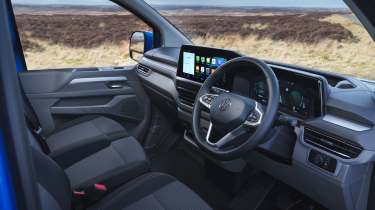
Pros |
Cons |
|
|
Climb inside and there’s a lower roof than the old Transporter, so the cab has a more cosy feel. You’ll still find plenty of headroom, and it’s easy to get comfortable. There’s a excellent visibility with Volkswagen retaining large twin door mirrors with normal and blind-spot mirrors on both sides.
There’s no shortage of clever features in the cab, and the designers have paid lots of attention to making sure you can keep all your mobile devices and tools topped up between jobs. There are USB-A, USB-C and 12-volt chargers, along with a 230-volt outlet mounted at the base of the driver’s seat in diesel versions. PHEV and electric versions can offer even more juice, with two optional 230V sockets in the luggage compartment that can provide up to 2.3kW in total. One item that hasn’t been carried over from Ford to VW is the Transit Custom’s optional tilting steering wheel, which can also double as a table.
Infotainment, sat-nav and stereo
For better or worse, the cockpit of the latest Transporter is all new and fully digital, featuring a 12-inch instrument display and a 13-inch central touchscreen that supports Apple CarPlay, Android Auto, and numerous online services. This is based on Ford software, but with new graphics to tie-in with VW’s ecosystem.
The central screen also takes care of the climate control settings, which is something of a backwards step for usability from the physical controls of the old T6.1. However, they do at least remain in a band that’s always on display across the bottom of the screen, so you don’t have to go hunting for them in sub-menus. Beneath the screen there are also a few physical buttons to jump straight to important settings such as the parking cameras, windscreen demister and driving mode.
Buying and owning
The core VW Transporter diesel range is straightforward, and most buyers are likely to stick with the entry-level trim and 109bhp engine with a manual gearbox. This offers great value and the best fuel economy figures. lf you think the black bumpers on this version look too low rent, the Commerce Plus gets body-coloured trim and extra features, so it’s a pretty big upgrade.
For extra performance, the 148bhp diesel could also be a worthwhile option, while operators with lots of short trips and urban driving should consider the electric e-Transporter.
Alternatives
The medium van class is the most popular in the UK, so the Transporter isn’t short of rivals. First off, it has to beat the Transit Custom which was designed alongside. That’s no mean feat, because the Ford is widely regarded as the best medium panel van. It just piped the Transporter to be named our best mid-size van choice in the 2025 Auto Express New Car awards, helped by a wider choice of engine options that aren’t available at the moment in the Transporter.
Then the Transporter needs to fend off the Vauxhall Vivaro, Citroen Dispatch, Peugeot Expert, Fiat Scudo and Toyota Proace - all of which also share the same fundamental underpinnings. After that, there’s the Renault Trafic and Nissan Primastar. If you fancy an upmarket van, you could also consider the electric Volkswagen ID. Buzz Cargo - although it does offer less cargo space - or the Mercedes Vito.
Van dimensions | |||
| Body style | Height | Width | Length |
| L1H1 van | 1,978mm | 2,032mm | 5,050mm |
| L2H1 van | 1,978mm | 2,032mm | 5,450mm |
| L2H2 van | 2,480mm | 2,032mm | 5,450mm |
Load area dimensions | ||||
| Body style | Height | Width | Length | Volume |
| L1H1 van | 1,316mm | 1,392-1,777mm | 2,602mm | 5.8m3 |
| L2H1 van | 1,316mm | 1,392-1,777mm | 3,002mm | 6.8m3 |
| L2H2 van | 1,870mm | 1,392-1,777mm | 3,002mm | 9.0m3 |
Frequently Asked Questions
Yes, we reckon its similarities to the Ford Transit Custom make it one of the best vans on sale.
